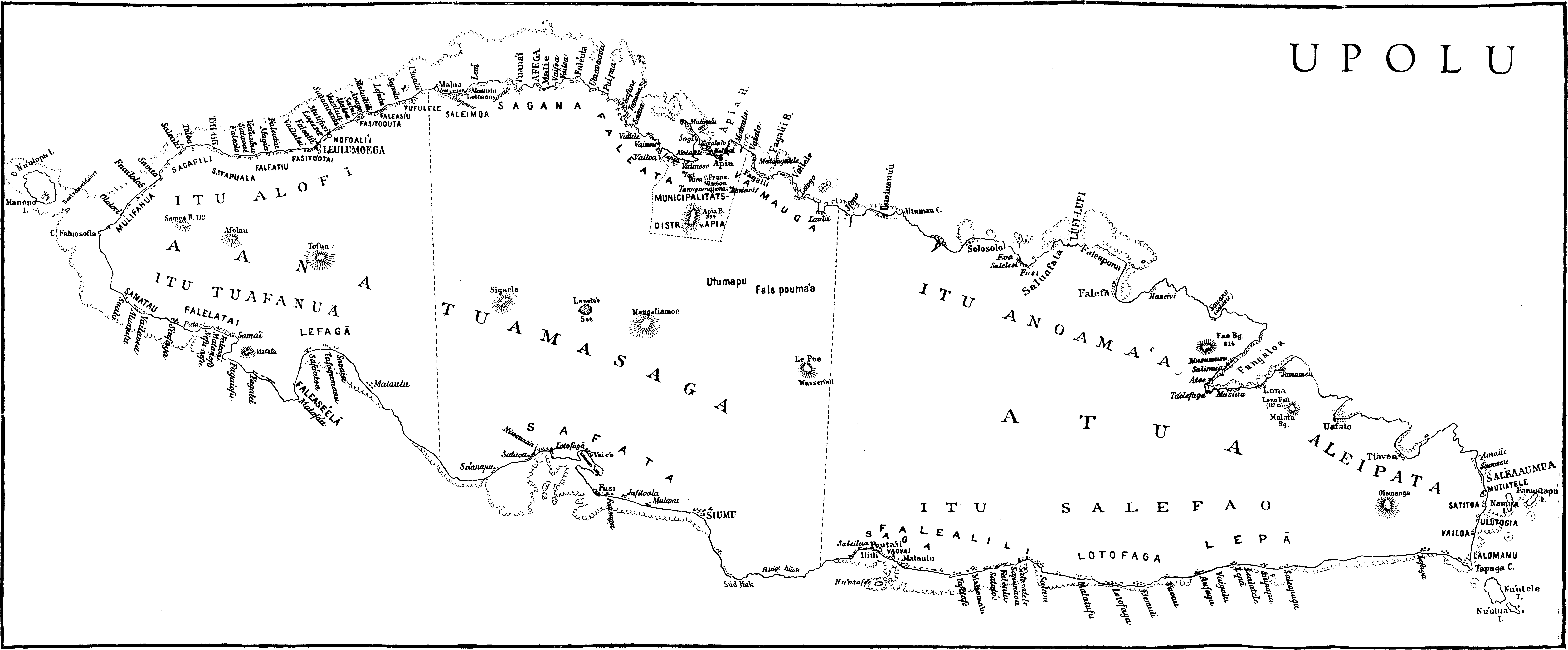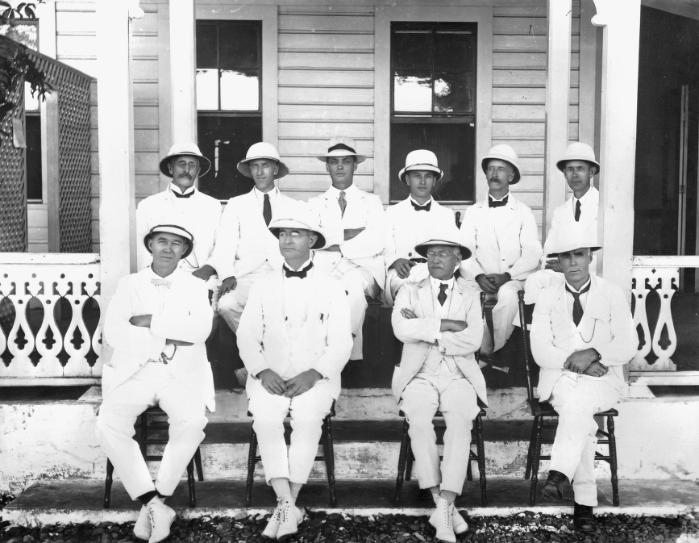|
Mulinuʻu
Mulinuʻu is a small village situated on a tiny peninsula on Upolu island in Samoa. It became the site of the colonial administration in Samoa in the 1870s and continues to be the site for the Parliament of Samoa. It is located on the central north coast of the island and is part of the urban area comprising Apia, the country's capital. Overview Mulinuʻu peninsula, where this and some other villages are situated, is the site of the Fale Fono or Parliament House in Samoa as well as the Lands and Titles Court. At the tip of the peninsula is the meteorology office which was initially established in the late 19th century as an observatory. The peninsula is also the site for several important tombs including that of the previous Head of State, Malietoa Tanumafili II. The population of Mulinuʻu village is 27. It is part of Tuamasaga Tuamāsaga is a district of Samoa, with a population (2016 census) of 95,907. This makes it the most populous district in Samoa. The geographic area ... [...More Info...] [...Related Items...] OR: [Wikipedia] [Google] [Baidu] |
Apia
Apia () is the Capital (political), capital and largest city of Samoa. It is located on the central north coast of Upolu, Samoa's second-largest island. Apia falls within the political district (''itūmālō'') of Tuamasaga. The Apia Urban Area (generally known as the City of Apia) has a population of 35,974 (2021 census). Its geographic boundaries extend from the east approximately from Letogo village in Vaimauga to the west in the newer, industrialized region of Apia which extends to Vaitele village in Faleata. History Apia was originally a small village (the 1800 population was 304), from which the country's capital took its name. Apia Village still exists within the larger modern capital of Apia, which has grown into a sprawling urban area that encompasses many villages. Like every other settlement in the country, Apia Village has its own ''matai'' (leaders) and ''fa'alupega'' (genealogy and customary greetings) according to fa'a Samoa. The modern city of Apia was foun ... [...More Info...] [...Related Items...] OR: [Wikipedia] [Google] [Baidu] |
Malietoa Tanumafili II
Malietoa Tanumafili II (4 January 1913 – 11 May 2007) was a Samoan paramount chief and politician who was O le Ao o le Malo (head of state) of Samoa from its independence in 1962, and the holder of the Malietoa title from 1940, until his death in 2007. After becoming the Malietoa, he worked as a civil servant and parliamentarian. When the state of Western Samoa was founded in 1962, gaining independence from New Zealand, he became joint head of state with Tupua Tamasese Meaʻole, who died on 15 April 1963, after which he remained the office's sole occupant until his own death. Early life Tanumafili was born on 4 January 1913 as the son and third child of his parents, Malietoa Tanumafili I and Momoe Lupeuluiva Meleisea. He inherited the royal title of Malietoa in 1940, following the 1939 death of his father, Malietoa Tanumafili I, though some media reports claim that he received the title of Malietoa in 1939. The Malietoa is one of the four '' tamaʻāiga'' (maximal ... [...More Info...] [...Related Items...] OR: [Wikipedia] [Google] [Baidu] |
Samoa
Samoa, officially the Independent State of Samoa and known until 1997 as Western Samoa, is an island country in Polynesia, part of Oceania, in the South Pacific Ocean. It consists of two main islands (Savai'i and Upolu), two smaller, inhabited islands (Manono Island, Manono and Apolima), and several smaller, uninhabited islands, including the Aleipata Islands (Nuʻutele, Nuʻulua, Fanuatapu and Namua). Samoa is located west of American Samoa, northeast of Tonga, northeast of Fiji, east of Wallis and Futuna, southeast of Tuvalu, south of Tokelau, southwest of Hawaii, and northwest of Niue. The capital and largest city is Apia. The Lapita culture, Lapita people discovered and settled the Samoan Islands around 3,500 years ago. They developed a Samoan language and Culture of Samoa, Samoan cultural identity. Samoa is a Unitary state, unitary Parliamentary system, parliamentary democracy with 11 Districts of Samoa, administrative divisions. It is a sovereign state and a membe ... [...More Info...] [...Related Items...] OR: [Wikipedia] [Google] [Baidu] |
Tuamasaga
Tuamāsaga is a district of Samoa, with a population (2016 census) of 95,907. This makes it the most populous district in Samoa. The geographic area of Tuamasaga covers the central part of Upolu island, and includes the capital, Apia. History and politics Malie & the Malietoa The paramount '' matai'' title of Tuamasaga is the Malietoa title. Led by Auimatagi, Sa Malietoa and the nine senior orators of Malie are responsible for the election of the Malietoa titleholder at Niuʻula in Malie. Given that the district of Aiga-i-le-Tai ( Manono and Apolima) and the district of Faʻasaleleaga on Savaiʻi are two key footholds of the Aiga Sa Malietoa (Malietoa clan), Malie often consults with Manono (capital of Aiga-i-le-Tai) and Safotulafai (capital of Faʻasaleleaga) in the election of the Malietoa. The village of Malie is the seat of the Malietoa. At a national level, the Malietoa title is one of the four ''Tama-a-Aiga'' (noble families) titles. Apia Apia () is the Cap ... [...More Info...] [...Related Items...] OR: [Wikipedia] [Google] [Baidu] |
Scene
Scene (from Greek ') may refer to: General * Scene (performing arts), a part of the story held in a single location * Scene (perception), a set of information that can flow from a physical environment into a perceptual system via sensory transduction Arts, entertainment, and media Music *Scene (subculture), a youth subculture from the early 2000s characterized by a distinct music and style Groups and performers * Scene, the stage name used by Japanese Punk guitarist Minoru Kojima * Selena Gomez & the Scene, an American band * The Scene (Canadian band), a late 1960s psychedelic Canadian band * The Scene (Dutch band), a Dutch band formed by Thé Lau Albums * ''Scene'', a 2005 noise album by Merzbow * ''Scenes'' (album), a 1992 music album by Marty Friedman * ''The Scene'' (Eskimo Callboy album), an Eskimo Callboy album * ''The Scene'', the debut album of The Scene Other uses in music * S.C.E.N.E. Music Festival, an annual festival held in downtown St. Catharines, Ontar ... [...More Info...] [...Related Items...] OR: [Wikipedia] [Google] [Baidu] |
Upolu
Upolu is an island in Samoa, formed by a massive basaltic shield volcano which rises from the seafloor of the western Pacific Ocean. The island is long and in area, making it the second largest of the Samoan Islands by area. With approximately 145,000 inhabitants, it is by far the most populous of the Samoan Islands. Upolu is situated to the southeast of Savai'i, the "big island". Apia, the capital, is in the middle of the north coast, and Faleolo International Airport at the western end of the island. The island has not had any historically recorded eruptions, although there is evidence of three lava flows, dating back only to between a few hundred and a few thousand years ago. In the Samoan branch of Polynesian mythology, Upolu was the first woman on the island. James Michener based his character Bloody Mary in ''Tales of the South Pacific'' (later a major character in the Rodgers and Hammerstein musical, '' South Pacific'') on the owner of Aggie Grey's Hotel on the so ... [...More Info...] [...Related Items...] OR: [Wikipedia] [Google] [Baidu] |
Legislative Assembly Of Samoa
The Legislative Assembly (), also known as the Parliament of Samoa (), is the national legislature of Samoa, seated at Apia, where the country's central administration is situated. Samoan Parliament is composed of two parts: the O le Ao o le Malo (head of state) and the Legislative Assembly. Parliament has been dissolved since 3 June 2025. In the Samoan language, the Legislative Assembly of Samoa is sometimes referred to as the Samoan Fono while the ''government'' of the country is referred to as the Malo. The word ''fono'' is a Samoan and Polynesian term for councils or meetings great and small and applies to national assemblies and legislatures, as well as local village councils. The modern government of Samoa exists on a national level alongside the country's '' fa'amatai'' indigenous chiefly system of governance and social organisation. In his or her own right, the O le Ao o le Malo can summon and call together the Legislative Assembly, and can prorogue or dissolve Parlia ... [...More Info...] [...Related Items...] OR: [Wikipedia] [Google] [Baidu] |
Populated Places In Tuamasaga
Population is a set of humans or other organisms in a given region or area. Governments conduct a census to quantify the resident population size within a given jurisdiction. The term is also applied to non-human animals, microorganisms, and plants, and has specific uses within such fields as ecology and genetics. Etymology The word ''population'' is derived from the Late Latin ''populatio'' (a people, a multitude), which itself is derived from the Latin word ''populus'' (a people). Use of the term Social sciences In sociology and population geography, population refers to a group of human beings with some predefined feature in common, such as location, race, ethnicity, nationality, or religion. Ecology In ecology, a population is a group of organisms of the same species which inhabit the same geographical area and are capable of interbreeding. The area of a sexual population is the area where interbreeding is possible between any opposite-sex pair within the area ... [...More Info...] [...Related Items...] OR: [Wikipedia] [Google] [Baidu] |




